Michael Weinstein is a seasoned writer and a dedicated expert in work safety, footwear, and popular shoe brands. With years of research and expertise, he's...Read more
Michael Weinstein is a seasoned writer and a dedicated expert in work safety, footwear, and popular shoe brands. With years of research and expertise, he's...Read more
Let’s be honest: Kids can get you difficult times when it comes to choosing a pair of shoes or boots. Measuring the feet size, keeping the growing room in mind, knowing that it should be comfortable, and most importantly, deciding the right shoe size altogether!
Seems overwhelming? Yeah, it definitely is! But no worries, things can be much easier with professionals’ shoe sizing guide. To measure your kids’ boot or shoe size, you’ll have to trace out the feet in the daytime. After that, measure the traced markings, convert that into shoe sizes (US or UK), and get the boots!
Well, there’s more to it, for sure. There are things to consider in the measuring process, and there are pro methods to avoid guesswork. So, why not get you through the nagging process real quick? Let’s get your lovely kid the right size shoes or boots today.
What Is the Right Shoe/boot Size for My Kids?
Depending on the age of your kid, you’ll have a few measurement standards. While your kid is 5 years old, S/he may wear 13 size shoes for children while for a 6 year-old kid, it will be 1 size for young.
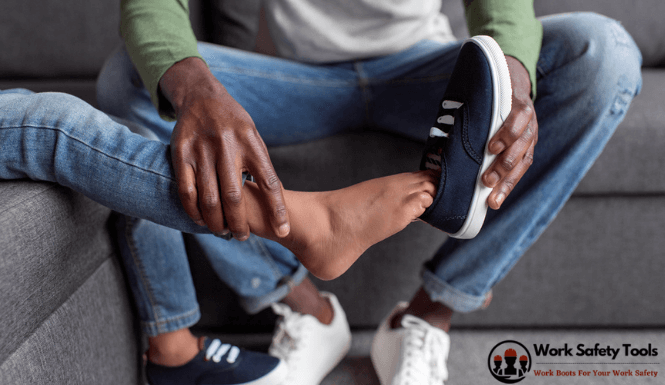
On the other hand, your sizing process will also be different depending on whether you’re measuring a boy’s or a girl’s feet (more on this later).
Kids Shoe & Boots Size Charts: Measurements, Age and Conversion Chart
Okay, that’s a bit confusing. Let’s give you a feasible size chart with which you can understand which way you have to take. You’ll get a clear idea of infant, toddler shoe size chart by age, along with bigger kids from these charts:
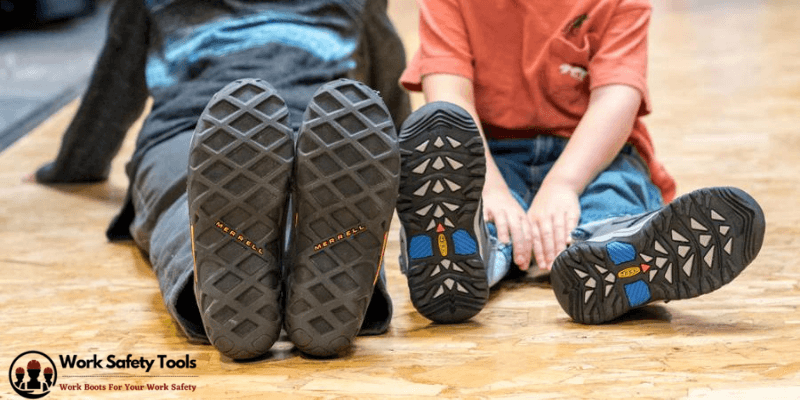
Infant (up to 1 year) Boot size chart With conversion
|
Heel to Toe Measurement |
Boot Size |
||||
| In Centimeter | In inches | US size | UK size | Canada size | EU size |
| 7.9 cm | 3 ⅛ Inches | 0 | 0 | 0 | 15 |
| 8.9 cm | 3 ½ Inches | 1 | 0.5 | 1 | 16 |
| 9.5 cm | 3 ¾ Inches | 2 | 1 | 2 | 17 |
| 10.5 cm | 4 ⅛ Inches | 3 | 2 | 3 | 18 |
| 11.4 cm | 4 ½ Inches | 4 | 3 | 4 | 19 |
| 12.1 cm | 4 ¾ Inches | 5 | 4 | 5 | 20 |
| 12.7 cm | 5 Inches | 5 ½ | 4.5 | 5 ½ | 21 |
| 13 cm | 5 ⅛ Inches | 6 | 5 | 6 | 22 |
| 13.3 cm | 5 ¼ Inches | 6 ½ | 5.5 | 6 ½ | 23 |
Toddler (2-4 years) Boot size chart With conversion
|
Heel to Toe Measurement |
Boot Size |
||||
| In Centimeter | In inches | US size | UK size | Canada size | EU size |
| 14.3 cm | 5 ⅝ Inches | 7 ½ | 6.5 | 7 ½ | 24 |
| 14.6 cm | 5 ¾ Inches | 8 | 7 | 8 | 24 |
| 15.2 cm | 6 Inches | 8 ½ | 7.5 | 8 ½ | 25 |
| 15.6 cm | 6 ⅛ Inches | 9 | 8 | 9 | 25 |
| 15.9 cm | 6 ¼ Inches | 9 ½ | 8.5 | 9 ½ | 26 |
| 16.5 cm | 6 ½ Inches | 10 | 9 | 10 | 27 |
| 16.8 cm | 6 ⅝ Inches | 10 ½ | 9.5 | 10 ½ | 27 |
| 17.1 cm | 6 ¾ Inches | 11 | 10 | 11 | 28 |
| 17.8 cm | 7 Inches | 11 ½ | 10.5 | 11 ½ | 29 |
| 18.1 cm | 7 ⅛ Inches | 12 | 11 | 12 | 30 |
Small kids (4-8 years) Boot size chart With conversion
|
Heel to Toe Measurement |
Boot Size |
||||
| In Centimeter | In inches | US size | UK size | Canada size | EU size |
| 19.1 cm | 7 ½ Inches | 13 | 12 | 13 | 31 |
| 19.4 cm | 7 ⅝ Inches | 13 ½ | 12.5 | 13 ½ | 31 |
| 19.7 cm | 7 ¾ Inches | 1 | 13 | 1 | 32 |
| 20.3 cm | 8 Inches | 1 ½ | 14 | 1 ½ | 33 |
| 20.6 cm | 8 ⅛ Inches | 2 | 1 | 2 | 33 |
| 21 cm | 8 ¼ Inches | 2 ½ | 1.5 | 2 ½ | 34 |
| 21.6 cm | 8 ½ Inches | 3 | 2 | 3 | 34 |
Big kids/Youth (8-12 years) Boot size chart With conversion
|
Heel to Toe Measurement |
Boot Size |
||||
| In Centimeter | In inches | US size | UK size | Canada size | EU size |
| 22.2 cm | 8 ¾ Inches | 4 | 3 | 4 | 35 |
| 22.9 cm | 9 Inches | 4 ½ | 3.5 | 4 ½ | 36 |
| 23.2 cm | 9 ⅛ Inches | 5 | 5 | 5 | 36 |
| 23.5 cm | 9 ¼ Inches | 5 ½ | 4.5 | 5 ½ | 37 |
| 24.1 cm | 9 ½ Inches | 6 | 5 | 6 | 38 |
| 24.4 cm | 9 ⅝ Inches | 6 ½ | 5.5 | 6 ½ | 38 |
| 24.8 cm | 9 ¾ Inches | 7 | 6 | 7 | 39 |
Pro tip: With the chart in your hand, before you go ahead and order a pair of boots, know this: You can get boots slightly bigger than the size your kid needs: maybe ½ inches bigger. However, don’t go for a whole size bigger. In that case, your kid might trip over and hurt him/herself.
Are Boys and Girls Shoe Sizes the Same?
Just because of physiological differences between males and females, measuring the right shoe sizes becomes harder. Depending on whether you have a male kid or a female one, the measuring method can be significantly different!
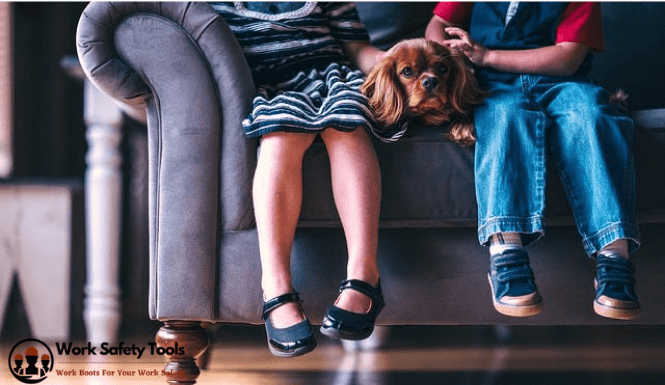
To help you out on that, let’s give you a compilation of the average shoe size for kids size chart by age:
If You’re Measuring a Male Kid’s Feet
Here is the shoe size chart if you’re buying a male kid a new pair of shoes:
| Age | Male Kid’s Shoe (US) size |
| NB (newborn) | Baby’s size 1 |
| 6 months | Baby’s size 2 or 3 |
| 1 year | Baby’s size 4 or 5 |
| 18 months | Baby’s size 5 or 6 |
| 2 years | Baby’s size 6 or 7 |
| 3 years | Baby’s size 9 or 10 |
| 4 years | Children’s size 10 |
| 5 years | Children’s size 11 |
| 6 years | Children’s size 12 |
| 7 years | Youth (Junior) size 1 or 2 |
| 8 years | Men’s size 4 |
| 9 years | Men’s size 5 or 6 |
| 10 years | Men’s size 6 |
| 11 years | Men’s size 7 or 8 |
| 12 years | Men’s size 8 |
If You’re Measuring a Female Kid’s Feet
And this is the shoe size chart you need if you’re buying a female kid a new pair of shoes:
| Age | Female Kid’s Shoe (US) size |
| NB (newborn) | Baby’s size 0-1 |
| 6 months | Baby’s size 2 or 3 |
| 1 year | Baby’s size 4 or 5 |
| 18 months | Baby’s size 5 or 6 |
| 2 years | Baby’s size 6 or 7 |
| 3 years | Baby’s size 9 or 10 |
| 4 years | Children’s size 10 |
| 5 years | Children’s size 11 |
| 6 years | Children’s size 12 |
| 7 years | Youth (Junior) size 1 or 2 |
| 8 years | Men’s size 4 |
| 9 years | Men’s size 5 or 6 |
| 10 years | Men’s size 6 |
| 11 years | Men’s size 7 or 8 |
| 12 years | Men’s size 8 |
Width Fittings and Heel Sizes
Getting the right length is not the last thing you need to know while getting a pair of new shoes for your kid. You also have to know the right heel size, both for the width, and the height.
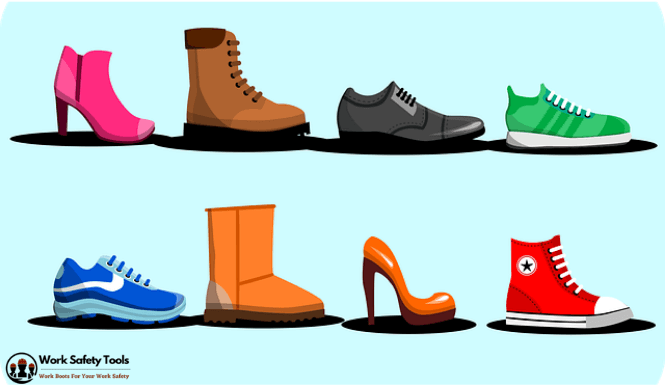
Therefore, manufacturers categorize the shoe sizes above int a few different types and indicate them with letters. Let’s get you through them real quick.
Heel size indicators by width
The letters may vary from one manufacturer to another. So, we’ll include the major ones you’d find in the stores:
| Heel Width | Indicator Letter |
| Narrow | N, D, E |
| Medium | M |
| Regular | R, F |
| Youth (regular) | Y |
| Wide | W, G |
| Extra wide | WW, E, XW, EE, H |
Heel size indicators by Height
Your kid (especially daughter) may want to wear heels a little higher than average. Here’s the heel height you can go for, depending on the age. Higher the age, higher the heel can be:
| Heel Height | Heel type |
| Up to 0.5 cm | Flat heel |
| 0.5 to 2 cm | Low heel |
| 2 to 3 cm | Medium |
| 3 to 4 cm | High heel |
How Do I Know What Size Shoe to Buy My Kids?
First off, you want to measure shoe size, as the chart above guides you to. After that, the best thing to do is try a few pairs on before you finally buy one. For that, you can use the size measuring trial pairs found in the shops (most shoe or super shops have them).
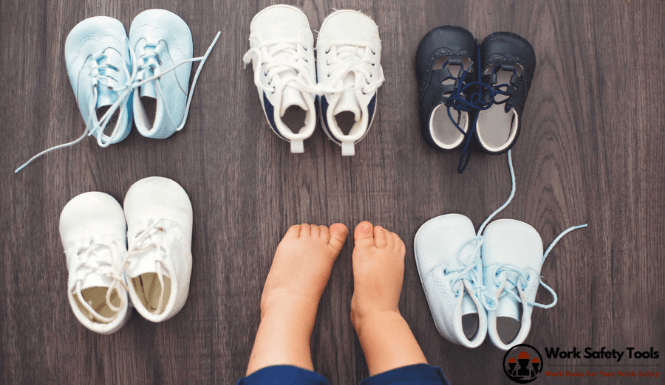
Once the pair is put on your kid’s feet, make sure the shoe snugly fits around the feet. But you want enough room to move inside the shoes. To ensure that, you need about half an inch (about the size of your thumb) of gap between the toe and the tip of the shoe/boot.
How Should Kids’ Shoes Fit?
Now, you also want your kid to grow but still be able to wear these shoes for a while, right? So, how do you know if kids boots fit? Well, you do that by either asking your kid, or doing a thumb test.
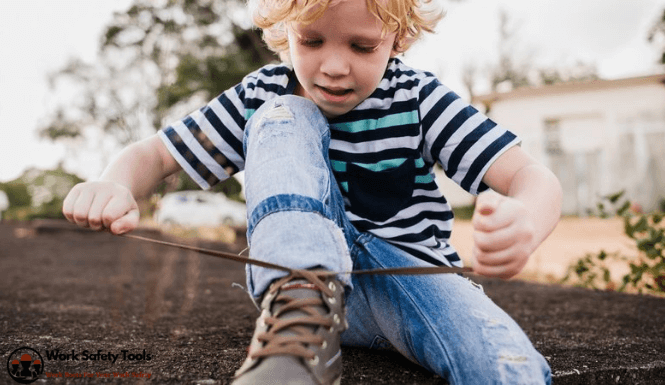
Ask your kid if he/she can move the fingers comfortably inside the boots. If the kid is too small to understand what comfort is, here’s what you can do: Pinch the toe side and see if your child has room to move inside.
Additional Fit Tips for Kids’ Boots and Shoes
You want the right size boots or shoes for your child, and you want to do it efficiently. Here are a few additional tips that will help you do just that:
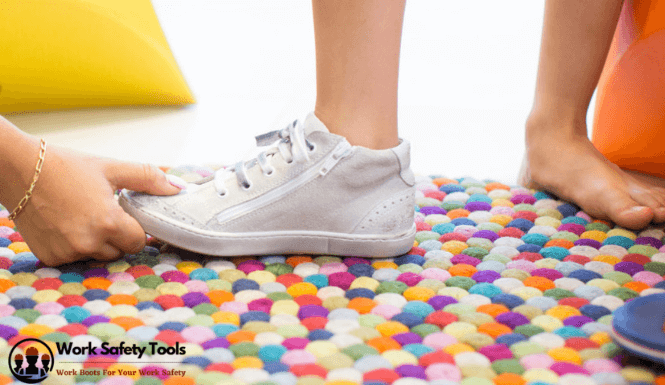
Measure at the end of the day
Our feet naturally expand throughout the day, giving you the largest size in the afternoon. So, be sure to shop around for shoes at the end of the day instead of morning or noon. That way, you’ll have the best measurement.
Always fit the larger foot
Just like any other human, chances are, your kid also has one foot larger than the other. So, measure both feet and take the larger size as standard. We’ll talk about the process of measuring in detail later on.
Ask your kid for assurance
No matter how well the shoes fit your kid’s feet, let comfort be your deciding factor. Ask your kid to walk around a bit and make sure s/he is comfortable while walking. If your kid understands things, ask for assurance of comfort.
Heavyweight kids need adult sizes
If your kid weighs way more than the standard BMR, skip ahead and look for a smaller adult’s shoe sizes. Since your kid has larger feet diameter and needs more room to breathe, this step is necessary to ensure comfort.
Don’t have break-in periods
Adult’s shoes usually have break-in periods where you wear the shoes for a few days before the material shapes up. However, for kids’ shoes, you don’t expect any break-in periods. Make sure it doesn’t have hard material, tags or seams inside. Or that might cause discomfort, even blisters down the line.
Why are Shoe Sizes Different for Kids and Adults in Europe and the US
First off, there’s no difference between male and female kids’ feet sizes. However, when it’s about comparing between adult and kids, you might get confused. You’ll have the same numbers with different sizes for kids and adults. This comparison works differently in the US and Europe.
The US shoe sizes follow the barleycorns measures at around ⅓ inches (8.47 mm) as the unit of length. On the flip side, the European shoe sizes are measured by Paris points. This method equals to roughly 0.262 inches (6.67 mm) as the single length unit.
You’ll have to add 2 Paris Points to the last measured feet size, giving you a straightforward measuring method. But for US sizes, there are some math to be done. First, you multiply the Last measurement of your feet by 3, then subtract 24 for male. For female, in the US sizing, you subtract 23, instead of 24.
As a result, you get a difference in the end measure. To put that into perspective, the smallest size of US size is 1 whereas, for Europe, it’s 0, the smallest size available (for infants). You’ll find measuring names from K1 to K13 in stores with the US sizing for kids. For adults, it starts with 1, all the way up as you want.
How Much Space Should a Child Have in Their Shoes?
Kids grow fast. Really fast. So, when you’re buying a pair of new shoes for your kid, keep the growing room in mind. In that contrast, you must get a pair of shoes larger than your feet. But that won’t be more than half a size bigger.
If your kid has a shoe size kid’s 11, the shoes you want to get will have about 11.5, not 12. The extra room will help your kid breathe and still wear while getting the feet bigger. If you get a full size bigger, or 12 instead of 11.5, that’s too loose and can cause accidents by tripping over.
How to Measure Your Kids Feet (step by step)
Now you know how things are taken into account while deciding the right size shoes for your kids. But all this will go in vain if you can’t measure the feet size of your kid in the first place. And here is how you do that, step by step:
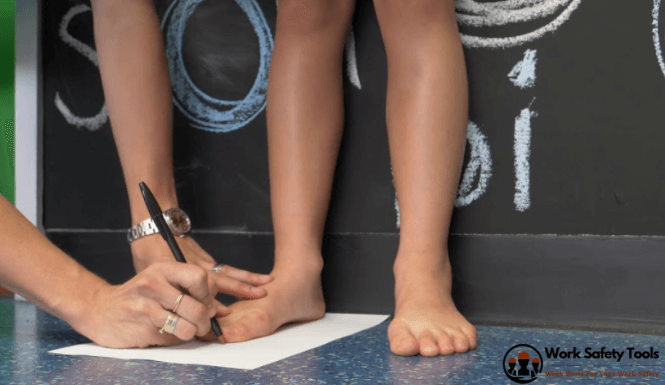
Quick Tips for Measuring Kids’ Feet
Before the process, let’s have a look at a few quick tips before you start with the measurement process:
- The obvious one: Don’t forget to check out the size chart offered by the brand.
- Measure both feet with separate notes and take the larger foot as a reference.
- Put the whole body weight on the scale or sheet to get maximum accuracy.
- Try a few different pairs before deciding on the final one to go with.
How to Measure Kids Shoe/Boots Sizes (step by step)
Here are the steps to follow while measuring the feet for the right shoe or boot size for your kid:
Step 1: Trace out the foot
If you’re measuring the feet at home, take a piece of white paper, a pencil, and a measuring tape. Put your kid’s feet on the sheet, press firm, and mark the starting (tip) and ending (heel) points of the foot. Keep the pencil straight at a 90° angle while doing so.
Step 2: Match it with the size chart
Once you know your kid’s feet length marked, measure it with the tape and match it with the size chart given above. However, that’s not when you finalize the shoe size. As said before, you try the measured sizes before you go for one.
Step 3: Do a double check
This should be easy to measure the feet again, but it’s necessary to have an accuracy you’ll be proud of. Have your kid stand on the sheet again at a different time of the day, and measure both feet. And as said before, you take shoes for the larger feet, not the shorter one.
Basic Kids’ Shoe Shopping Principles
Buying the first pair of shoes for your kid should be followed by some principles. Here are they:
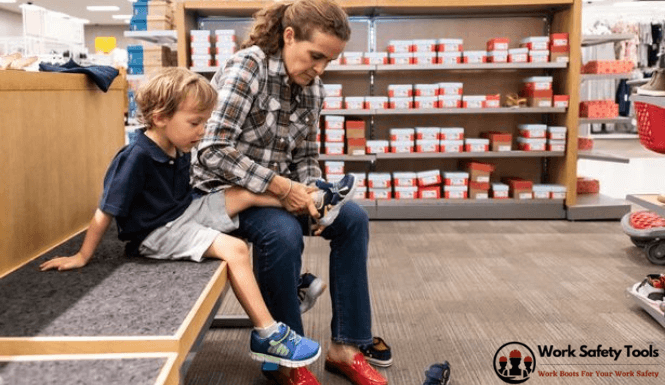
- It doesn’t matter how well you’ve measured, don’t buy until tried on feet.
- Don’t go too snug fit, nor too loose while fitting the shoes.
- Measurement notations are usually effective from age 6, be it US, EU, or UK.
- Baby, Youth, Adult males, and females have different sizes. Y 5.5 is the same as male 6 and female 7.
- If your kid is going to wear the boots/shoes with socks on, try the boots with the regular socks on.
Tips for Trying on Kids’ Boots
Knowing what to avoid when buying kids’ boots is more important than the ones you should know. While buying the boots, remember what shoes do podiatrists recommend for children. The boots must be soft, comfortable, and true to the size it stands for. Do the feet slide into the shoes too easy? Then you might want to double-check another size with a size less.
Frequently Asked Questions
Got more questions about kids’ boots or shoes sizes? We get that a lot. Hence, let’s answer some of the most common queries about shoe sizing, especially for kids:
Is children’s size 5 the same as adults?
No, if you look at the big kid shoe size chart, children’s shoe size 5 will not be the same as adults’ shoe size 5. While a kid needing size 5 shoes will have 12.1 cm circumference (length), an adult will have it around 23 cm.
Should kids boots be snug or loose?
The ideal shoe fittings for kids should neither be too tight fit, nor too loose. It rather should be a loosely snug fit, slightly larger than the necessary shoe size. This way, you’re making sure the kid will have growing room while wearing them for a while.
How much room should be in the toe of a boot?
For the growing room in kids’ shoes, the measure should be around a quarter to half an inch. Having more than that will cause walking issues and tripping off. And less than that will result in buying a new pair earlier than necessary.
Should I buy shoes a half size bigger for kids?
Getting up to half a size bigger shoe for kids is okay for the sake of growth rate. However, never make the mistake of getting too loose, or your kid will trip over too often.
Is it OK to wear boots a size too big?
Unless you’re getting a pair of boots for the next year, you should not go for a pair of boot size, too bigger than necessary.
Are boot sizes smaller than shoe size?
Boot sizes mostly will not be the same as your shoes are measured. This is because in most cases, boots are measured with different lasts. But you can find the same size boots and shoes that fit as well!
How often do kids need new shoes?
If your kid (especially toddlers) has the growth rate correct, you may have to buy a new pair of shoes every 2 to 4 months or so. Getting half a size bigger shoe in the first place may extend the period a bit.
Conclusion
There can be nothing beautiful enough than watching your kid walking in a pair of shoes. As getting the right size pair is necessary, we hope you now know how to do that. Get your kid the shoes or boots you want by following the measuring charts you want.
Now that you know how to size kids boots and shoes, don’t forget to follow the hacks of getting it right. Measure in the evening, try them on first and make sure the boots fit comfortably. Best of luck seeing your kid running around comfortably in his/her new shoes!
Recent Posts
Puma sneakers have different sizing depending on the specific style and model. It's recommended to check the product description or reviews for each sneaker to determine if they run small or large....
How To Lace Puma Shoes? If you're a fan of Puma shoes and want to learn how to lace them, you've come to the right place! Lacing your Puma shoes properly not only adds a stylish touch but also...
